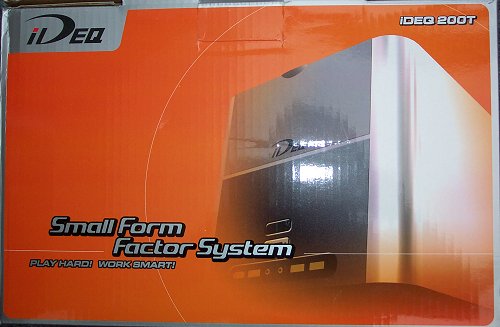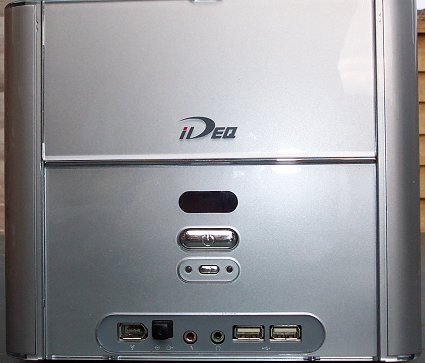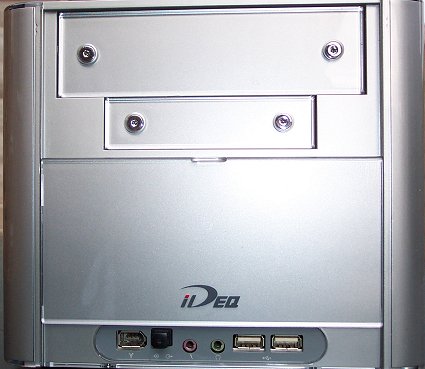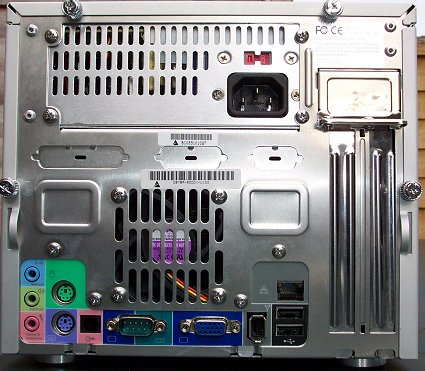External thoughts
Our usual method is to investigate both the external and internal virtues of any SFF unit and then look at performance.
Presentation is an important point if one is trying to create an impression of style. SFF PCs have sought to move away from using standard beige colouring. We're usually confronted with an anodised aluminium finish that acts as a style statement and, more practically, a large heatsink. The potential uses of these cubes are obvious. Their diminutive size lends itself well to portability and the number of features opens up the way for a powerful multimedia box that's equally at home in the lounge as in the bedroom. I should write catchlines, shouldn't I ?.


One of our complaints with the Shuttle line of SFFs lay with their bare look. On most XPCs, the front housed a 5.25" and 3.5" bay, and with appropriate drives in place, colour mismatching often took place. We lamented that it would be handy to hide the drives when not in use. The front of the iDEQ is classic Shuttle, that is, it's plastic-fronted with the aforementioned drive coverings. However, as the two near-identical pictures highlight, the iDEQ 200T allows one to cover the drives when required. It's a simple matter of raising or lowering a matching plastic panel. The downside is that the bright, trendy power and hard drive lights are obscured when the plastic panel is lowered. More importantly, we feel, the InfraRed receiver is also obscured, and IR technology works from a line-of-sight perspective.

A close-up of the features section, going from left to right, shows standard FireWire support, S/PDIF-In, microphone and headphone jacks and a couple of ubiquitous USB2.0 ports. We feel as if Biostar should have kept the minimalistic look going by providing a cover for these features, too. The front is generally good, and it also feels well-constructed. However, with the competition ready to utilise anodised aluminium fronts, Biostar's interpretation looks a little 'cheap' in comparison, very much along the lines of Shuttle's first AGP-equipped SFF systems.


The rear of the iDEQ 200T offers plenty of ventilation opportunities; a must for the relatively cramped internal dimensions of these cubes. Interestingly, the aluminium case isn't fabricated from a single piece. Rather, Biostar uses three separate panels for the top and sides respectively. From personal experience, it's often a little tricky getting a one-piece covering back on efficiently. A three-piece design, as seen here, allows the user to meddle with the sides or top without having to remove the entire 'case'. It's not that much of a feature, it's just good thinking on Biostar's part.
Ports-wise, there's the standard audio jacks on the left, PS/2 ports, S/PDIF-Out for digital transfers to compliant equipment, Serial, VGA output via a HD15 interface, a single FireWire connection and a RJ45 LAN port sitting on top of a further 2 USB2.0 ports. That brings immediately usable high-speed connectivity to 4 x USB2.0 and 2 x FireWire 1394a. A VGA connection dictates some form of on-board video and with the Intel i865G chipset provide the heart of the iDEQ 200T, you'll not be surprised to learn that Intel's Extreme Graphics 2 is charged with exporting video. SFF systems literally cry out for a S-Video socket. That increases their usable feature set considerably. Unfortunately, Biostar has seen fit to exclude it. A pretty large omission in our eyes, especially if you're already specifying some form of on-board video.
Other than that, it is exactly what you'd expect in a modern SFF PC. A nice touch is the way you can remove the side covers by slipping a finger in just below the thumbscrews. No more having to grope the sides in an effort to prise the hood away. Just a note here - the sides need to be removed before the top piece can be taken away. The sides also feature small ventilation slots that should help cooling. Let's open her up now.









